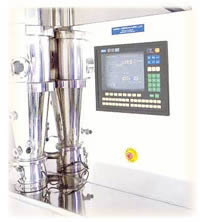Fluid Bed Agglomerators
Fluid Bed Agglomerators are used in the process of agglomeration commonly in chemical industries. Fluid bed technology is used. Powder is fluidized with hot air and sprayed simultaneously with a binder liquid. This process causes particle adhesion, agglomerate formation and drying, and is applicable to both batch and continuous operation. Control of air velocity and wetting rate determines the final agglomeration size. The process produces agglomerates of narrow size distribution: Lower range 100 microns mean size, upper range 1000 microns mean size.
Process
The process of fluidised bed spray agglomeration plays an important role in the formulation of powders in the food and pharmaceutical industries as dust-free and free-flowing particles can be produced in a process with favourable heat and mass transfer conditions and good solids mixing. A liquid suspension, solution or melt is sprayed onto a bed of solids in order to induce stickiness and agglomeration.
An important adhesion mechanism is the formation of liquid bridges between the particles or sintering via viscous flow. The kinetic energy of the collision is dissipated by friction, viscous forces in the liquid film and plastic deformation. Consecutive drying in the hot fluidization air hardens inter-particle bridge bonds and stable agglomerates are formed.
Agglomeration behaviour of food particles
Visco-plastic material properties strongly affect the agglomeration behaviour. They are dominated by the supra-molecular particle structure as well as process parameters like temperature, liquid content and rate of deformation. Most food powders and granules are amorphous water-soluble substances. Their mechanical material properties vary widely at different temperature and moisture content. The glass transition concept is used to describe their behaviour. The current study investigates the influence of process parameters on structure and strength of amorphous maltodextrin particles agglomerated in a fluidised bed.
Modelling on the scale of micro-processes
The dynamics of the agglomeration process are dominated on the micro level by the interactions between individual particles as well as wetting and drying processes. To describe the kinetics of agglomeration, a process model must consider these micro-mechanisms. For this purpose, the discrete element method (DEM) is suitable. This method describes the movement of each individual particle, based on Newton's and Euler's equations of motion, and allows an exact description of the process including the underlying micro-mechanisms.To characterize the impact and breakage behaviour of food granules, a detailed contact model on the basis of an energy balance has been derived theoretically and verified by experiments. The contact model is the basis of a physically correct description of the interactions among particles and between particles and the wall. The application of DEM to the process of fluid bed agglomeration also requires a numerical description of the continuous gas phase (CFD). The coupling of DEM and CFD is achieved using the commercial software packages EDEM and Fluent.
Video
